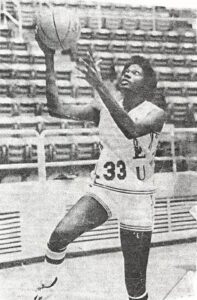By Jackie Hunt
Contributing Writer
Editor’s Note: This is the ninth installment of the When Marion Played Sports series. Click the link to see all the articles in the series.
The early to mid-1970s was a time of program building for Marion High School. Although the school was just a small lower classified school, it did not take long to see there was an abundance of talent on the campus. By 1976 Marion had shown itself to be capable of producing college level athletes in both basketball and baseball.

Long before his younger brother, Bobby Joe, set a national high school scoring record in 1980 averaging 54 points per game (a record which still stands), James Earl Douglas, had opened demonstrated that Marion players could move to play at the college level. The senior Douglas starred in baseball and basketball at St. John’s Junior College in Kansas and later Paul Quinn College in Dallas. He was the first of many Marion stars to draw all-star and all-state recognition. Douglas continued to hone his skills as he spent years as All-Army shortstop, representing the service in competition around the world.
Larry “Short” Wayne matriculated to Grambling where he walked on to the baseball team and became the starting catcher for his final three years. Wayne (Toughie as he was called at Grambling) had been an Honorable Mention all-state player at Marion and a member of Marion’s coveted 30-point club as a basketball player. Wayne says he earned his spot on the team with a willingness to do what was necessary, including volunteering to catch hours of batting practice, something other catchers did not want to do. He says that Marion High’s hard throwing left-hander, Jeff Wayne, was as good as any pitcher at Grambling before he decided to leave college school and pursue work.
Other baseballers from his era that he felt were exceptional included Michael Hunt, David Cain, Fred Jaggers and Ruey Cooper.
The 30 Point Club was a motivational award created by hoops coach Malcolm George. It recognized players for reaching that scoring mark in a game. A framed photo and recognition in the school trophy case came with the coveted award. Records indicate that the practice might have ended when Coach George left the school to become principal elsewhere and was never reinstated. Athletes who received that award were James Douglas, Bruce Waters, Albert Jackson, Edgar Burch, Larry Wayne and Linda Andrews-Collins. While there were more than likely others, the records are difficult to obtain.

Marion’s Linda Andrews-Collins’ 9.3 rebounds a game and her .502 field goal percentage still rank in ULM’s all-time top 10.
Andrews-Collins was a two-time team MVP before graduating Marion in 1976. When she claimed the award as a junior, her male counterpart was Larry Wayne with Jackson joining her during her senior year. She was also recognized as an all-state player and had a career high of 43 points against Junction City enroute a sweet-16 appearance. While at Northeast she led the team in rebounds as a freshman and her 9.3 rebounds per game average still sits at #5 on ULM’s all-time list. Her .502 field goal percentage ranks 8th in school history
She recalls her teams at Marion as being all about winning, saying, “We didn’t care about individual stats. We were all playing to win.” She remembers her teams’ togetherness during their 33-5 season in 1976 and the unselfish play of others like Wanda Jackson, Jamie Wisecarver, and Cheryl Riley. Their togetherness dated back to 1973 when they were neophytes helping Diane Traylor and Jackie Moore anchor a very good squad that had gone 18-9.
The ladies, coached by C. W. Wheeler, advanced to the regional finals in 1972 and followed that up with solid seasons from ’73 to 75 before their school record 33 wins in 1976.
The boys on the other hand, struggled through those early ‘70s years, as indicated by a 4-17 record in 1973. This was a few years ahead of the days when they, too, would become a force to be reckoned with. Few could have imagined that Coach George was building a program that would eventually be feared as much as Wheeler’s girls. The hey-day of Panther basketball started in the late ‘70s and rolled right into the ‘80s.
As the program blossomed, players came and went, and legacies grew. Now, years later a generation of off-springs of these early stars has emerged doing big things in sports. Stay tuned as we talk about “Legacies.”
 fgazette.com Community news site for Union Parish Louisiana
fgazette.com Community news site for Union Parish Louisiana